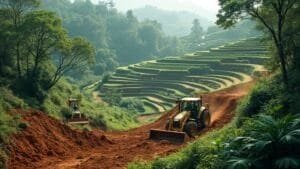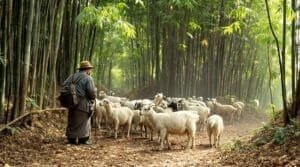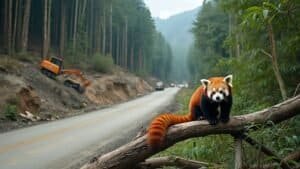Red pandas are increasingly threatened by one of the most pressing environmental issues of our time: deforestation. But how does deforestation impact red panda populations? These tree-dwelling mammals depend on dense, high-altitude forests rich in bamboo and nesting trees for survival. As logging, agriculture, and infrastructure development reduce and fragment these habitats, red pandas face severe challenges—from food scarcity and disrupted movement patterns to increased exposure to predators and human conflict
In this article, we explore the primary causes and scale of forest loss in red panda ranges, its impact on bamboo availability and reproduction, and the conservation strategies underway to restore and reconnect their natural environment
The Impact of Deforestation on Red Panda Populations

Deforestation is one of the most significant threats facing red panda populations in the wild. As forests are cleared for human development, red pandas lose access to the critical components of their habitat—dense tree canopies, bamboo understory, and secure nesting sites
These forest ecosystems, spanning across the Eastern Himalayas and the mountain ranges of southwestern China, are being fragmented and degraded at alarming rates. The cumulative effects of this habitat loss go beyond just reducing space—they alter how red pandas feed, reproduce, and survive
Causes of Forest Loss in Red Panda Habitats
Red panda habitats are primarily affected by deforestation linked to agricultural expansion, timber harvesting, infrastructure development, and fuelwood collection. In countries like Nepal and India, where many red panda habitats lie outside protected areas, local communities depend on forest resources for subsistence. In eastern Nepal’s Panchthar-Ilam-Taplejung corridor, more than 70% of red panda habitat is in community-managed forests that are increasingly being encroached upon by farmland and grazing zones
Additionally, logging—both legal and illegal—is a persistent issue. High-value hardwoods are extracted for construction, while undergrowth is cleared to increase access for livestock. Infrastructure projects such as road and hydropower development also contribute to widespread forest degradation. In Arunachal Pradesh and Sikkim, road-building efforts have cut through core red panda habitat, creating new edges that degrade the microclimate needed for bamboo regeneration
These cumulative pressures result in habitat fragmentation, where previously continuous forests are divided into small, isolated patches. Fragmentation leads directly to population isolation, reduced breeding opportunities, and an increased risk of local extinctions
Scope of Habitat Loss from Deforestation
The scale of habitat loss due to deforestation is significant. According to the World Wildlife Fund (WWF), nearly 50% of red panda habitat is located in the Eastern Himalayas—a region experiencing high rates of deforestation due to both rural population growth and commercial land use. Satellite mapping from 2000 to 2018 revealed that over 1,700 square kilometers of red panda habitat were lost during this period alone, with fragmentation affecting many more areas
In Nepal, where the Red Panda Network has concentrated its monitoring efforts, more than 400 separate forest patches now comprise what was once a continuous red panda range. These patches are often too small to support viable red panda populations over time, especially if they are cut off from bamboo stands or lack suitable tree cover for nesting
The result is a steady decline in the quality and continuity of habitat, which reduces the carrying capacity for red panda populations and increases mortality risks due to exposure, starvation, and poaching. Some forest patches are so isolated that red pandas are effectively trapped, unable to move to richer feeding grounds or establish new territories
Decline in Bamboo Availability
Red pandas are dietary specialists, relying on bamboo for over 98% of their nutritional intake. They consume bamboo leaves, shoots, and stems year-round, and need consistent access to these plants to meet their metabolic needs. Deforestation disrupts this delicate balance in multiple ways
First, bamboo is often cleared during land conversion or damaged by livestock grazing in deforested areas. Without forest canopy to regulate moisture and temperature, bamboo struggles to grow, especially in the dry season. Over time, these areas become unsuitable for bamboo regeneration
Second, deforestation changes the structure of the forest floor. Increased sunlight exposure and soil erosion degrade the bamboo root system, while invasive grasses and weeds may outcompete native bamboo species in disturbed areas. According to data from the Red Panda Network, heavily deforested sites in Nepal show bamboo density reductions of up to 40% compared to intact forests
Finally, bamboo undergoes natural die-off cycles every few decades. In healthy, connected ecosystems, red pandas can migrate to other patches when this happens. But in fragmented, deforested landscapes, such migration is often impossible, leading to starvation and local declines
The cumulative effect is a decline in food security for red pandas. This not only impacts adult survival but also affects reproductive success, as females need high nutritional intake during gestation and lactation. To explore this further, readers can refer to the WWF red panda page, which highlights how forest degradation and bamboo loss are driving red panda endangerment in the Eastern Himalayas
Ecological and Biological Consequences

As deforestation reshapes red panda habitats, the ecological stability and biological functions critical to their survival begin to unravel. Habitat fragmentation forces red pandas to adapt their movement patterns, alters their feeding efficiency, and reduces opportunities for successful reproduction. These disruptions increase their exposure to predators, human conflict, and environmental stress, creating a cascade of consequences that accelerates population decline
Fragmentation Effects on Red Panda Movement
Red pandas are primarily arboreal and rely on continuous forest canopy to travel safely between feeding and nesting sites. In fragmented habitats, the natural corridors that once supported their movement are interrupted, forcing them to descend to the ground more frequently. This not only increases their exposure to terrestrial predators, like wild dogs and martens, but also places them at risk of human-related threats such as vehicle collisions and poaching
A 2021 study published in Movement Ecology used GPS telemetry to reveal that red pandas in fragmented environments traveled significantly longer distances and displayed more erratic movement patterns than those in continuous forests. These behaviors are indicative of elevated stress and reduced habitat quality
Additionally, edge effects—altered environmental conditions at the boundary of forest patches—exacerbate the problem. These areas often lack sufficient bamboo, have more fluctuating temperatures, and are less sheltered from wind and predators. Red pandas tend to avoid these zones, effectively reducing the usable area within fragmented habitats
As their range becomes more patchy, red pandas are increasingly unable to find mates, leading to reduced genetic exchange and lower reproductive success. Small, isolated populations also face a higher risk of local extinction due to environmental fluctuations or disease outbreaks
Increased Human-Wildlife Interactions
Deforestation brings red pandas into closer contact with humans, especially in regions where their remaining habitat lies adjacent to farmland or villages. This proximity leads to increased interactions—often negative—with people and domestic animals
Red pandas have been found raiding crop fields or entering settlements in search of food, particularly when their bamboo sources are exhausted. In such cases, they may be trapped or killed by locals who view them as pests. More commonly, however, they fall victim to incidental trapping or injury from snares intended for other wildlife, such as deer or wild boars
Free-roaming dogs present one of the most severe threats. These animals can harass, injure, or kill red pandas and are known carriers of diseases like canine distemper virus (CDV), which is often fatal to wildlife. A study by the Red Panda Network showed that areas with higher dog densities corresponded with reduced red panda presence, indicating avoidance behavior that may fragment habitat even further
As deforestation reduces the natural buffer zones between red panda territory and human activity, the frequency and intensity of these encounters will likely increase, leading to greater mortality and stress-related health issues
Reproductive Challenges Linked to Forest Degradation
Red panda reproduction is closely tied to the quality of their habitat. Females require secure, insulated den sites—usually tree hollows in mature forests—and access to abundant bamboo to support the energy demands of pregnancy and nursing. When these resources are compromised by deforestation, reproductive success drops significantly
In degraded habitats, the number of suitable nesting trees is often reduced due to logging or the removal of old-growth vegetation. This forces females to either delay reproduction or settle in suboptimal dens that offer less protection from the elements and predators. Studies in eastern Nepal have documented lower cub survival rates in fragmented and deforested zones compared to intact forests
Furthermore, nutritional stress from bamboo loss can suppress estrus cycles or result in underweight mothers, both of which negatively affect reproductive outcomes. In fragmented environments, the added stress of navigating unsafe territories can also disrupt hormonal balance, leading to reduced fertility
Long-term monitoring by the Red Panda Network indicates that populations in continuous, protected forests have significantly higher cub-to-adult ratios than those in areas affected by deforestation. This data reinforces the direct link between habitat quality and reproductive success in red pandas
To understand how these ecological consequences are being addressed, the Red Panda Network threat page provides extensive information on current challenges and the science-backed efforts to mitigate them
Regional Risks and Conservation Responses

The impact of deforestation on red panda populations is not uniform across their range. Geographic regions experience varying degrees of habitat loss based on local development pressures, land-use practices, and conservation policy. Understanding these regional dynamics is essential for implementing targeted strategies that can mitigate deforestation and its cascading effects on red pandas
Fortunately, a combination of grassroots efforts, policy reforms, and international collaboration is making progress in protecting and restoring the species’ fragmented habitats
Geographic Hotspots of Red Panda Habitat Loss
Among the most critically affected areas is the Panchthar-Ilam-Taplejung (PIT) corridor in eastern Nepal. This region is home to a significant proportion of Nepal’s red panda population, yet over 70% of its forest is unprotected. Fragmentation here is driven by expanding agriculture, livestock grazing, and the use of forest land for firewood and fodder collection. As a result, more than 400 fragmented forest patches now define the red panda’s home range in this corridor
In India, the state of Arunachal Pradesh hosts a large portion of the country’s red panda habitat, but road expansion, logging, and shifting cultivation (jhum farming) are degrading forest quality. Even in Sikkim, where conservation awareness is relatively higher, habitat encroachment continues near human settlements and along tourist routes
Southwestern China, particularly Sichuan and Yunnan provinces, also faces deforestation pressure, though national reforestation policies have slowed the rate of forest loss. Still, habitat fragmentation persists due to older patterns of logging and newer threats like hydropower dam construction
Bhutan remains a positive outlier. Thanks to strong environmental protections, over 70% of the country is forested, and red panda habitat is largely intact. However, even here, the growing demand for roads and agricultural expansion is starting to challenge forest stability in mid-elevation zones where red pandas thrive
These regional differences necessitate tailored approaches—what works in Bhutan may not be sufficient in Nepal or India, where red panda habitats are more deeply embedded in human-dominated landscapes
Anti-Deforestation Strategies and Habitat Restoration
To address the multifaceted impact of deforestation on red panda populations, a variety of conservation strategies have been developed, with increasing emphasis on community-based and landscape-scale interventions
One of the most impactful initiatives is the “Plant A Red Panda Home” campaign by the Red Panda Network. This program focuses on reforesting degraded red panda habitat in Nepal using native species, including bamboo. By restoring vegetation corridors between fragmented patches, the campaign enables safer movement for red pandas and supports genetic flow across populations. As of 2023, thousands of saplings have been planted, with local communities trained and paid to maintain them
In addition to reforestation, wildlife corridor establishment is a key tool for reconnecting habitat. These corridors, protected through zoning agreements or rewilding, allow red pandas to move freely across their natural range. Projects in the Kangchenjunga Landscape—a transboundary region spanning Nepal, India, and Bhutan—exemplify this corridor-based approach
Policy measures are also evolving. India’s Wildlife Protection Act and Nepal’s Red Panda Conservation Action Plan incorporate deforestation mitigation through land-use restrictions, expanded buffer zones, and community forest governance. These policies help regulate logging and promote sustainable harvesting of forest products
Local stewardship plays a pivotal role. Programs that engage community forest user groups, provide alternative livelihoods (such as ecotourism or sustainable agriculture), and involve schools in environmental education have shown to reduce dependence on forest resources. When communities are invested in red panda survival, habitat protection becomes a shared goal
On an international level, organizations like WWF and IFAW support red panda conservation through funding, policy advocacy, and research. Cross-border collaborations help unify monitoring efforts and standardize anti-deforestation strategies across the red panda’s fragmented range
To read more about how reforestation and regional policy are addressing habitat threats, visit this overview by Earth.org on red panda endangerment, which includes updates on current conservation progress and challenges












